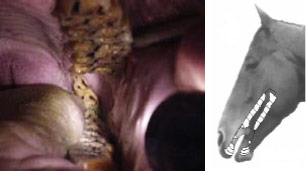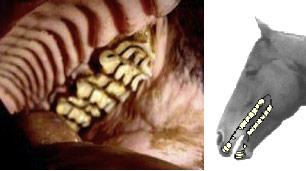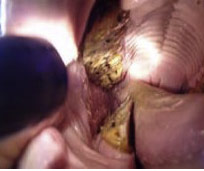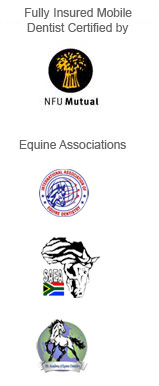
Hooks
These can be on the upper 6's. Hooks can push the jaw out of alignment . Large hooks may reach the mandible, interfering with rostral movement of the mandible during mastication and poll flexion, causing severe pain by impinging on the soft tissue and underlying bone in the interdental space. On the upper 11's these can have the same effect, and can occur in conjunction with ramps.

Ramps
Ramps are often found in conjunction with hooks. A ramp forms when the lower 6 is not worn evenly by its opposing tooth. Lower 11 ramps often become so long that they impinge on the roof of the mouth. This situation is potentially hazardous because the palatine artery is located very close to the area.

ATR'S
Accentuated Transverse Ridges. These are side to side ridges that form along the molar arcades. They are caused by wearing the softer area of cementum across the outer surface of the teeth. Transverse ridges can be reduced by floating or burring and will improve when other problems causing poor alignment, such as hooks and ramps are removed.

WAVE
The entire molar arcades have become uneven and developed the appearance of a wave. This often starts because of other problems causing the misalignment of the teeth, such as deciduous caps, missing teeth or large hooks and ramps. A wave will prevent the jaw from moving freely and will inhabit the proper grinding of food. Molar waves can be corrected by floating and correcting other problems, this is likely to be a long term problem that will need to be managed regularly.

STEP
Step is a distinct bump within the molar teeth, where one or more of the teeth have grown longer than its opposing tooth. This may occur when a deciduous cap is retained too long preventing normal growth, allowing the tooth opposite to grow too long. A step can be reduced by floating or burring regularly.

SHEAR
A shear mouth is the extreme angle of the surface of the molar arcades. Shear mouth forms when a horse has an unusually large difference in the width of the upper (wide) and lower (narrow) jaw and can greatly inhabit the movement of the jaw. Shear mouths are difficult to correct but regular floating prevents the angles from becoming too extreme. A normal molar angle is 10 to 15 deg shear mouth is 15 deg plus.

